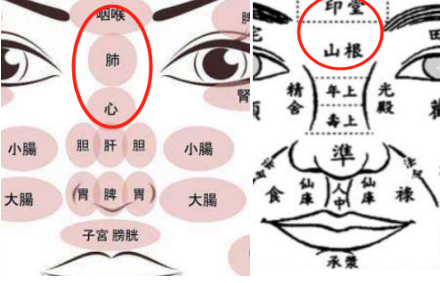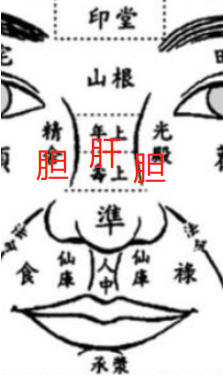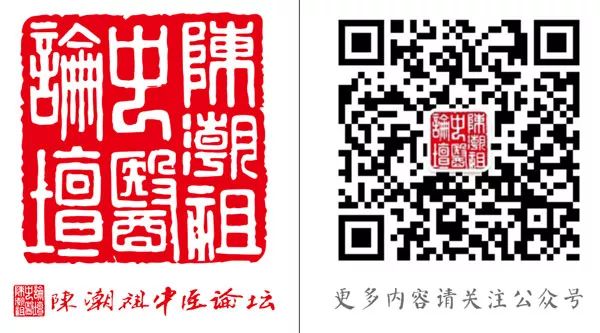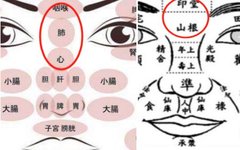
The nose is located centrally on the face, also known as Ming Tang (Hall of Brightness). The nose connects above to the throat and directly to the lungs, assisting the lungs in respiration, serving as the external orifice of the lungs. The lungs and nose not only cooperate in physiological functions but also influence each other pathologically; therefore, examining the nasal orifice can reveal the physiological and pathological conditions of the lungs.
There are corresponding areas of various organs located on and around the nose (the organs are centrally located, while the six fu organs are on either side). The nose is also closely related to the meridians. The connection between the nose and the organs is primarily through the pathways of the meridians: the Foot Yangming Stomach Meridian (Zu Yangming Wei Jing) begins at the outer side of the nose and ascends to the root of the nose; the Foot Taiyang Bladder Meridian (Zu Taiyang Pangguang Jing) starts at the root of the nose; the Hand Yangming Large Intestine Meridian (Shou Yangming Da Chang Jing) runs along both sides of the nostrils; the Hand Taiyang Small Intestine Meridian (Shou Taiyang Xiao Chang Jing) travels from the cheeks to both sides of the nose; the Du Meridian (Du Mai) descends to the nasal column and the tip of the nose. Changes in these meridians and related organs can be diagnosed through alterations in the nose.
Thus, Traditional Chinese Medicine (TCM) places great importance on the nose, believing that “the five organs are uniquely determined by the hall.” Observing the nose can not only diagnose changes in the lungs and spleen-stomach but also assess the deficiency or excess of the organs and the state of the stomach qi, predicting the severity of the condition and prognosis. Of course, in clinical practice, one should not rely solely on the nasal manifestations to diagnose diseases; other pulse and symptom assessments must be considered for a comprehensive and accurate diagnosis. Below, we will discuss the observational diagnosis of the nose based on the classification in the Ling Shu (Spiritual Pivot) Five Colors, focusing on the upper, middle, and lower parts of the nose.
(1) Upper Part of the Nose
The area between the eyebrows—Que (the bridge of the nose), above the Que—throat, middle of the Que (Yintang)—lungs, below the Que (lower extreme, root of the nose)—heart. The upper part of the nose refers to the area from between the eyebrows to the root of the nose.

1. Clinical Significance of Normal and Abnormal Color
In normal individuals, the color of the upper part of the nose (primarily at Yintang) should be rosy, bright, and plump. Rosy indicates a healthy pinkish hue, bright refers to a healthy luster rather than a dull appearance, and plump means the skin is full rather than wrinkled. This area is traversed by the Foot Taiyang Bladder Meridian and the Du Meridian, with the Du Meridian originating between the two kidneys, and the Bladder Meridian connecting to the kidneys, both of which also connect to the brain. The kidneys govern the bones and produce marrow, while the brain is considered the sea of marrow. A full and rich upper nose indicates that a person has a relatively abundant Essence, with a vigorous function of the sea of marrow and strong intelligence. Abnormal colors include red, yellow, white, green, and black.
Yellow indicates weakness of the spleen and stomach with internal dampness, and insufficient qi and blood.
White suggests insufficient qi and blood supply to the Foot Taiyang Bladder Meridian, as it is closely related to the kidneys; the yang qi in the kidneys warms the back through the Bladder Meridian, and a white appearance indicates kidney yang deficiency and cold congealing in the meridians. In real life, those who are cold, have cold extremities, weak lower back and knees, dizziness, and lack of energy may exhibit a white appearance at Yintang.
Green indicates mild oxygen deficiency in the heart and brain, leading to easy fright; children with blue veins at Yintang often have spleen and stomach deficiency and cold, making them prone to diarrhea and colds.
Black is the color of kidney disease, indicating that kidney qi is failing, especially when the Yintang is black, which is a sign of critical condition, suggesting poor heart function, insufficient blood supply to the brain, and hypoxia in the heart and brain, even myocardial necrosis.
Red is commonly seen as a red appearance at Yintang, usually indicating overthinking and mental strain, leading to irritability, insomnia, high blood pressure, and temper issues, increasing the risk of stroke.
2. Clinical Significance of Normal and Abnormal Texture
The texture of the upper part of the nose is similar to wrinkles in other facial areas and should be assessed in conjunction with age. The texture pattern is often vertical lines between the eyebrows and fine horizontal lines at the root of the nose. Normality is determined by whether the wrinkles are prominent, appear too early, or show abnormal patterns.
For example, a prominent vertical wrinkle between the eyebrows indicates a strong personality, and such individuals often delay seeking treatment until their condition worsens; they tend to suppress anger, which can lead to elevated blood pressure or heart disease.
Individuals with two or more horizontal wrinkles between the eyebrows are often melancholic or overly worried, prone to anxiety, depression, and digestive issues; thus, they should try to maintain a positive mindset. Prominent horizontal wrinkles at the root of the nose are relatively rare and may indicate dysfunction of the heart and lungs, requiring further clinical data accumulation.
The texture of the root of the nose has unique advantages in pediatric diagnosis, known as Shan Gen Wang Zhen (Observing the Root of the Nose).

If the texture of the root of the nose in children is vertical, it is often associated with respiratory diseases such as colds, coughs, and asthma, similar to Western diagnoses of bronchitis, asthma, and upper respiratory infections. If the texture is horizontal, it is often related to digestive system disorders, commonly seen in conditions like stagnation, vomiting, diarrhea, and parasitic infections, akin to Western diagnoses of indigestion and enteritis. A mixed pattern of both horizontal and vertical textures indicates simultaneous respiratory and digestive system diseases, suggesting concurrent heart-lung and spleen-stomach issues.
(2) Middle Part of the Nose
Age—liver, age left and right—gallbladder. The middle part of the nose refers to the area from below the root of the nose to above the tip and wings of the nose.

1. Clinical Significance of Normal and Abnormal Color
The color of the middle part of the nose should be similar to that of the upper part, being rosy, bright, and plump. Abnormal colors are often compared to the surrounding skin, with clinical observations focusing on light and dark differences rather than the five colors indicating disease. Light colors are often associated with deficiency syndromes and dampness; dark colors are more commonly seen in blood stasis, qi stagnation, and water retention. A child with a red-purple nose column is prone to abscesses and purulent blood diseases. Currently, there is insufficient clinical data, and comprehensive judgment should be made in conjunction with the other three diagnostic methods.
2. Clinical Significance of Normal and Abnormal Texture
The texture of the middle part of the nose often presents as longitudinal wrinkles, which are most noticeable under side lighting or when smiling. The wrinkles should be fine and symmetrical, indicating normal morphology, suggesting good development of the liver, gallbladder, and other digestive organs, and stable emotions. Abnormal textures often manifest as significantly deepened wrinkles or horizontal folds. Currently, there is insufficient clinical data, and abdominal ultrasound may be performed to assess the liver and biliary system.
3. Common Forms of Stasis or Protrusions and Their Clinical Significance
Stasis or protrusions in the middle part of the nose are pathological, commonly appearing as spotted or patchy stasis, bony protrusions, and non-bony protrusions. For instance, if black-brown spots or patches appear on the skin of the nose bridge, they may be due to sun exposure or other causes of pigmentation; besides freckles, they can also be seen in chronic liver diseases.
If red patches appear on the skin of the nose bridge, with the lesions elevated and extending to the cheeks, they may indicate systemic lupus erythematosus. If the nasal column is numb and painful, with a hard purple color, it may indicate nasal carbuncle, caused by internal heat attacking upward and heat toxins congealing.
Bony protrusions on the nose bridge should raise suspicion of intracranial or nasal cavity occupying diseases.
(3) Lower Part of the Nose
The lower part of the nose primarily observes the tip of the nose and the wings on both sides. The tip of the nose corresponds to the spleen in TCM, while the wings correspond to the stomach.

1. Clinical Significance of Normal and Abnormal Color
The normal color of the nose should be a subtle red-yellow, indicating sufficient stomach qi. Based on color, one can assess the condition and prognosis. For example, if the tip of the nose is slightly yellow and bright, it may indicate a new illness, suggesting that the stomach qi is not harmed, indicating a mild condition; if seen in a chronic illness, it suggests recovery of stomach qi, indicating improvement. Other abnormal colors follow the five colors indicating disease.
(1) White Tip of the Nose
Indicates qi deficiency and blood loss, and in children, it indicates undigested food, spleen deficiency, and diarrhea. A white tip resembling dry bone indicates lung failure, which is a bad omen, but if the nose is white yet slightly moist, it may indicate survival.
(2) Yellow Tip of the Nose
Indicates internal damp-heat; yellow without luster indicates qi deficiency with phlegm; yellow-black and bright indicates internal blood stasis; dry yellow color, resembling earth, indicates spleen deficiency with dry fluids, a critical condition.
(3) Red Tip of the Nose
Indicates lung and spleen excess heat; slight redness indicates spleen channel deficiency heat; red, swollen, and ulcerated indicates stomach heat or blood heat; in measles patients, a red rash on the tip of the nose is often a good sign; if a woman has a wide, red nose wing, it may indicate amenorrhea. A red tip of the nose with papules that thickens over time, presenting as purple-red and uneven, resembling a tumor, is known as rosacea, often due to stomach fire attacking the lungs, compounded by wind-cold external binding.
(4) Blue Tip of the Nose
Indicates pain, often associated with severe abdominal or limb pain; a blue-yellow tip is generally seen in patients with dysuria.
(5) Black Tip of the Nose
If it appears slightly raised and bright, resembling an ointment, it indicates overeating or unclean food; if slightly black, it indicates internal water retention; if black and dry, it indicates signs of deficiency; if a man has a black tip, it often indicates lower abdominal pain; if the black extends to the philtrum, it indicates pain in the penis or testicles; black indicates labor; if the tip of the nose is black and dry, it indicates excessive sexual activity; if a woman has black on the tip of the nose, it indicates bladder or uterine pain; if the black extends to the philtrum, it indicates dysuria or lochia; if the nostrils are dry and black like charcoal, it indicates severe yang toxicity or dryness-heat in the large intestine, or fire attacking the lungs; if the nostrils are cold and slippery and black, it indicates extreme yin toxicity.
2. Clinical Significance of Normal and Abnormal Texture
Crab-claw lines, resembling the shape of a crab’s claw, are bright at the base and pointed, curved, and slender, resembling the branches of a tree. They are often found on the tip and wings of the nose and are often one of the early signs of liver disease, such as cirrhosis. Since the liver governs blood storage and the spleen governs blood regulation, liver disease can lead to disharmony of the spleen and stomach, resulting in bleeding. Western medicine may require endoscopy to rule out esophageal varices.
|
I Copyright Statement
I Submission Email: [email protected] |


